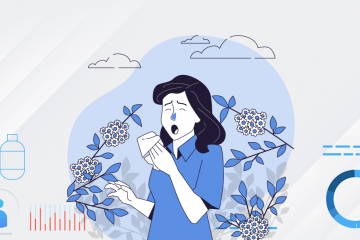Spring brings flower buds and flowering trees, but it also brings sneezing, irritation, a runny nose, and other troublesome symptoms to the billions of people who suffer from seasonal allergies. Seasonal allergies, often known as hay fever and allergic rhinitis, can be debilitating. However, before you settle for synthetic flowers and artificial turf, try these basic tactics for managing seasonal allergies. But, before understanding ways to prevent pollen allergies, let’s learn more about it.
What is Pollen?
Pollen is a fine grain-like substance produced by plants during the reproductive process. The pollen count is a count of the number of pollen grains in the air. Pollen counts are essential because they cause allergies such as hay fever and allergic rhinitis during high pollen seasons.
Did you know how old the systems used for measuring pollen count today are? Interested in learning more about the types of pollen? Read this blog to know all about it.
When are seasonal allergies at their highest?
Seasonal allergies are typically caused by pollen from three types of plants: trees, grass, and weeds. Seasonal allergies are so-called because each type of pollen has a season when it is most strong. The following is a general timeline of frequent pollen seasons:
– Tree pollen season lasts from March through June.
– Grass pollen levels are typically highest in June, July, and August, and can extend into September in a warm year.
– Weed pollen season lasts from August until the end of October, and it takes a harsh winter to destroy the weeds.
– Some outdoor molds are also more prevalent in the fall.
– Seasonal allergy sufferers can usually find some relief from November until early February.

A guide to pollen allergies with a month-on-month pollen calendar. The Pollen API determines the pollen forecast data and its pattern throughout the year.
There are many ways to prevent the exacerbation of pollen allergies. Most of the ways require us to stay protected against pollen exposure and know when the pollen count is at its highest:
1. After being outside, wash your face, especially your brows.
Pollen grains as small as a grain of sand can stick to brows and skin. Washing your hands is vital during flu season to reduce flu symptoms, and washing your face and brows after being outside can prevent eye and nasal allergy problems.
2. Wash your hair before going to bed after spending a long period outside, and change your pillows frequently.
Hair can act as a magnet for minuscule pollen grains and mold spores, especially if you spend a lot of time outside. Washing your hair (or your children’s hair) and changing pillowcases frequently will help limit exposure during sleep and reduce morning allergy flares.
3. Avoid wearing contact lenses or switch to daily disposable contacts to prevent allergies from accumulating on the lenses.
Pollen like ragweed, birch, and environmental irritants can all accumulate on contact lenses, resulting in increased red eye allergy during peak season. Using eyeglasses or daily disposable contacts will help you avoid this common hazard. When going outside, wear “wrap-around” shades to shield your eyes from pollen particles.
4. Avoid bringing pollen into your home, especially grass pollen.
Pollen can enter the home through unnoticed sources such as children’s shoes and clothing, dogs, especially after playing in the grass, and morning newspaper sleeves.
5. Replace air filters in your home and car on a regular basis.
Pollen can quickly accumulate on air filters during allergy season and then be transferred through ventilation into both homes and cars. To lessen this risk, use the highest pollen filter possible and change filters periodically.
6. Keep ducts in good condition
Many allergens can accumulate in the dark and damp ductwork that aids in the heating and cooling of the interior air. Small particles can cling to the ducts’ sides or any bends or grooves in the metal. Even if the system has clean filters, ducts that leak or do not vent correctly can recirculate contaminated air throughout the home. At least once a year, have an HVAC specialist inspect and clean all ducting. Replace any broken ductwork to ensure that the air in the system flows properly and that there is no backflow.
7. Launder outdoor clothing
Any clothing worn during outdoor activities should be washed right away. Before entering the shower, remove all clothing and place it in the washing machine, not a clothes basket. Do this as quickly as possible and before spending too much time sitting or strolling around the house.
Any delay in removal could lead to pollen contamination of the air. Remember to clean outside items such as eyewear, gardening tools, gloves, and sports equipment.
8. Reduce as many entry points as possible
When pollen levels rise, keep doors and windows closed since any breeze can push pollen through the window screens. Replace HEPA filters in air conditioning systems on a regular basis to keep the air as clean as possible. When the systems are in use, experts recommend that customers replace the filters in their air conditioning units once a month. Close any gaps or holes in your home since pollen can enter through any opening. Caulk around doors and windows, as well as any plumbing or electrical conduit that enters the home.
9. Before going outside, take an antihistamine or put on a pollen mask.
Take an antihistamine before going outside to mow the yard, rake leaves, play with your children, or engage in other pollen-inducing activities. Wearing a pollen mask is another simple technique to decrease your exposure to irritants. Most pharmacies provide pollen masks, which provide further protection against allergies.
10. Download a Weather and Pollen App on Your Smartphone.
So far, assessing the difficulties caused by pollen has been difficult due to a lack of data and precise information. However, with Ambee’s pollen app, you can stay informed and gain control by receiving tailored, location-based forecasts, recommendations, and risk assessments.
With accurate, real-time, and hyperlocal weather, air quality, and micro pollen data, you can now organize your daily work, outdoor exercises, vacation plans, and much more. You can also quickly inspect, track, monitor, and store an area to get a quick environmental overview. Identify the pollen count in the environment to avoid allergic rhinitis, hay fever, and other pollen allergies. The pollen count forecast data can also help you prepare for your activities while staying safe and healthy using Ambee’s simple and user-friendly app.
Try Ambee’s air quality and pollen app now.
When Home Remedies Don’t Work, Follow Alternative Treatments
A variety of natural therapies have been utilized to alleviate the symptoms of hay fever. Extracts of the shrub butterbur, spirulina (a form of dried algae), and other herbal medicines may help alleviate symptoms. There is insufficient data to demonstrate the safety and effectiveness of these treatments based on the small number of well-designed clinical trials.
Acupuncture research has yielded mixed findings, indicating that it may have limited value.
Before attempting alternative treatments, consult with your doctor.

A writer, nature lover and an environmental engineer. You can find me at Ambee’s office working with an amazing team to bring about positive change to our planet’s health. Being a big advocate of our environment, I write about technologies like AI, ML and Big data and its potential to save humankind from global warming.




